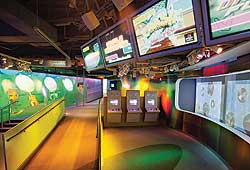|
By Alan Joch
Once upon a time, the design of a museum or exhibition took
a backseat to its content. Today, design is content, particularly
when a museum’s mission is to convey information, rather
than show objects. “There is a blurring of distinction
between object, experience, and story. Visitors are interacting
with ideas that have no physical presence,” says Deborah
Sussman, principal of Sussman/Prejza & Company, exhibition
consultants for the planned Museum of the African Diaspora
in San Francisco, which will trace the dispersal of African
peoples from the continent to other parts of the world.
For these projects, display technology has come to play a
central role, and it has evolved to the point where its hardware
can recede into the background so that visitors are not only
immersed in content but can interact with it, as well. Two
recent projects in Los Angeles and New York demonstrate different
ways that designers are experimenting with these capabilities.
Small thinking, big ideas
The Los Angeles County Museum of Art (LACMA) taps the energy
of artists to create experimental exhibitions in its Boone
Children’s Gallery. The latest effort, a 10-month exhibition
called nano that opened in December, highlights the work of
scientists who explore the world at the submicron level. “Our
challenge was to convey the nano-scaled world without creating
a corny version of Honey, I Shrunk the Kids,” says Bob
Sain, director of the LACMA Lab, the research and development
arm of the museum.
 |

The revamped Sony Wonder
Technology Lab features a display wall (right in
photo) that refracts and reflects light outside
the lab so that it’s visible to people in the
adjacent atrium.
Photography: © Scott Gries |
|
 |
Although the subject is at the cutting edge of scientific
research, the museum wanted the exhibition’s technological
underpinnings hidden from view. “The whole idea was to
not have any keyboards or monitors that were visible,”
says Victoria Vesna, a media artist who chairs the department
of design’s media arts program at UCLA, and who led the
creation of the show’s installations. “Instead,
through a series of projectors and embedded sensors, the exhibits
would come alive as people moved through the spaces.”
In conceiving nano, a core group of artists, architects,
and nano scientists achieved a level of collaboration that
“blurred, blended, and swirled together” their talents,
Sain says. The architect, Johnston Marklee & Associates
in Los Angeles, participated in the show’s first development
meetings. “This gave us insight into how to conceptualize
a very complex subject,” recalls firm principal Sharon
Johnston, AIA. Her partner, Mark Lee, adds, “Rather than
just listening to a client’s set of demands, we found
we had to be quite assertive architecturally. We started presenting
tangible ideas that the artists and the client could respond
to,” he says.
|


















